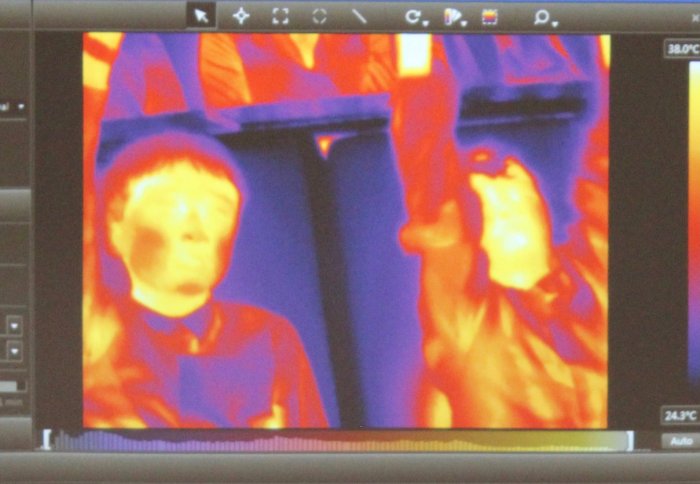Communicating with Heat - Professor Stepan Lucyszyn's inagural lecture

Communicating with Heat - Professor Stepan Lucyszyn's inaugural lecture took place on 4 May.
The inaugural lecture is one of the hardest to give. It marks the speaker’s promotion to full Professor. The lecture needs to impress one’s peers, colleagues and senior member of the College, and yet be understood by family, friends and visiting general public. Professor Lucyszyn decided to build on this challenge by inviting 9 to 12 year old school children, some from the nearby Hyde Park school as part of the College Outreach programme, conducting live demonstrations, and promising that there would be only simple (C = A/B) mathematics.

Professor Lucyszyn gave a brief overview of the electromagnetic spectrum, before discussing how we see visible light. Tom Wilson (Physics) demonstrated a solar cell that mimics how the human eye perceives light. Professor Lucyszyn went on to describe how the light frequencies seen by animals differ from humans.Today’s heavily overcrowded radio frequency spectrum has seen extensive commercial exploitation by the multi-trillion dollar telecommunications industry. However, even next generation 5G mobile communications is reaching practical frequency limits imposed by the high costs associated with operation at such short wavelengths. As a result, research by scientists and engineers is being carried out to find low cost solutions at terahertz frequencies and within the ‘Over the THz Horizon’ thermal infrared. Professor Lucyszyn said that he believed that this part of the spectrum is largely overlooked. He talked about some of the research currently being done in this area, as well as commercial technologies that include adaptive camouflaging of military tanks within the thermal infrared, magic wand remote controllers in the near infrared and high-speed data communications in the visible spectrum (known as LiFi).
Professor Lucyszyn said that university professors are professional inventors looking for problems to solve. One of his current interests is the ‘THz Torch’. Application of this simple low-cost technology, operating between 10 and 100 THz, could be short-range secure wireless communications and non-destructive testing. It fundamentally exploits engineered blackbody radiation, by partitioning thermally-generated spectral noise power into pre-defined frequency channels; the incoherent energy in each channel can then be independently pulsed modulated. The research started as an MSc student project, using miniature incandescent bulbs, which could only send data at 5 bits per second (bps). Over the past 5 years this has progressed to the demonstration of 1000’s bps 16-channel secure communications that can send data over a range of 40 cm, while only using 1.7 mm x 1.7 mm sub-milliwatt thermal sources within the transmitter.
Throughout his lecture Professor Lucyszyn entertained the audience and reinforced his message, with demonstrations of thermal infrared images of the audience, how the spectral range could be seen (or not) with energy emitted by a range of bulbs from the thermal infrared to the ultra-violet, the magic wand infrared controller and a demonstration of how the ‘THz Torch’ can be used to transmit data in the thermal infrared.
Professor Ian Robertson, from the University of Leeds, led the vote of thanks. Professor Lucyszyn was Professor Robertson’s first PhD student; working together for almost 30 years.
Stepan Lucyszyn is Professor of Millimetre-wave Systems and Director of the Centre for Terahertz Science and Engineering, at Imperial College London. After working in industry, as a satellite systems engineer for maritime and military communications, he spent 12 years developing microwave and millimetre-wave integrated circuit technologies at King’s College London and the University of Surrey. He came to Imperial College London in 2001 and worked on microelectromechanical systems, wireless power transfer and, more recently, terahertz and ‘Over the THz Horizon’ thermal infrared technologies.
Professor Lucyszyn has authored approximately 200 papers and 12 book chapters in applied physics and engineering, and delivered many Plenary and Keynote presentations at international conferences. He was an IEEE Distinguished Microwave Lecturer from 2010 to 2013, and has been a EuMA European Microwave Lecturer since 2013. Professor Lucyszyn was made a Fellow of the Institute of Physics (UK, 2005), Institution of Engineering and Technology (UK, 2005), The Electromagnetics Academy (USA, 2008) and the Institute of Electrical and Electronic Engineers (USA, 2014). In Apr. 2014, he co-founded the Imperial College London spin-out company Drayson Wireless Ltd.
Article text (excluding photos or graphics) available under an Attribution-NonCommercial-ShareAlike Creative Commons license.
Photos and graphics subject to third party copyright used with permission or © Imperial College London.